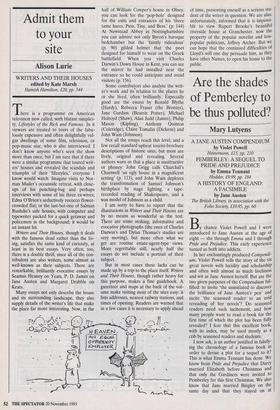Admit them to your site
Alison Lurie
WRITERS AND THEIR HOUSES edited by Kate Marsh Hamish Hamilton, £20, pp. 544
here is a programme on American television now called, with blatant simplici- ty, Lifestyles of the Rich and Famous. In it viewers are treated to tours of the fabu- lously expensive and often delightfully vul- gar dwellings of some film, television, or pop-music star, who is also interviewed. don't know anyone who's seen the show more than once; but I am sure that if there were a similar programme that toured writ- ers' houses and revealed the scandals and triumphs of their 'lifestyles,' everyone I know would watch. Imagine visits to Nor- man Mailer's oceanside retreat, with close- ups of his punching-bag and perhaps interviews with some of his three ex-wives; Edna O'Brien's seductively rococco flower- crowded flat; or the last-but-one of Salman Rushdie's safe houses, with computer and typewriter packed for a quick getaway and policemen in the background; it would be an instant hit.
Writers and Their Houses, though it deals with the famous dead rather than the liv- ing, satisfies the same kind of curiosity, at least in its best essays. Very often, too, there is a double thrill, since all of the con- tributors are also writers, some almost as well-known as their subjects. There are remarkable, brilliantly evocative essays by Seamus Heaney on Yeats, P. D. James on Jane Austen and Margaret Drabble on Keats.
Many essays not only describe the house and its surrounding landscape, they also supply details of the writer's life that make the place far more interesting. Now, in the hall of William Cowper's house in Olney, you can look for the 'pop-hole' designed for the exits and entrances of his 'three tame hares, Puss, Tiny, and Bess.' (p. 144) At Newstead Abbey in Nottinghamshire you can admire not only Byron's baroque bedchamber but the 'faintly ridiculous' (p. 90) gilded helmet that the poet designed for himself to wear on the Greek battlefield. When you visit Charles Darwin's Down House in Kent, you can see the mirror he had installed near the entrance so he could anticipate and avoid visitors (p. 156).
Some contributors also analyse the writ- er's work and its relation to the places he or she lived, often brilliantly. Especially good are the essays by Ronald Blythe (Hardy), Rebecca Fraser (the Brontes), Jane Gardam (Beatrix Potter), Michael Holroyd (Shaw), Alan Judd (James), Philip Mason (Kipling), Anthony Quinton (Coleridge), Claire Tomalin (Dickens) and John Wain (Johnson).
Not all the essays reach this level, and a few recall standard upbeat tourist-brochure descriptions of historic sites, but most are lively, original and revealing. Several authors warn us that a place is unattractive or phoney: John Grigg calls Churchill's Chartwell 'an ugly house in a magnificent setting' (p. 113), and John Wain deplores the transformation of Samuel Johnson's birthplace by stage lighting, a tape- recorded reading of Shakespeare, and a wax model of Johnson as a child.
I am sorry to have to report that the illustrations in Writers and Their Houses are by no means as wonderful as the text. There are some striking, informative and evocative photographs (the ones of Charles Darwin's and Dylan Thomas's studies are very moving), but more often what we get are routine estate-agent-type views. More regrettable still, nearly half the essays do not include a portrait of their subject.
But in most cases these lacks can be made up by a trip to the place itself. Writers and Their Houses, though rather heavy for this purpose, makes a fine guidebook. A gazetteer and maps at the back of the vol- ume make visiting most of the sites easy: it lists addresses, nearest railway stations, and times of opening. Readers are warned that in a few cases it is necessary to apply ahead of time, presenting oneself as a serious stu- dent of the writer in question. We are also, unfortunately, informed that it is impossi- ble to view Rupert Brooke's beautiful riverside house at Granchester, now the property of the popular novelist and less- popular politician, Jeffrey Archer, But we can hope that the continued difficulties of Lloyd's will one day persuade him, as they have other Names, to open his home to the public.










































































 Previous page
Previous page